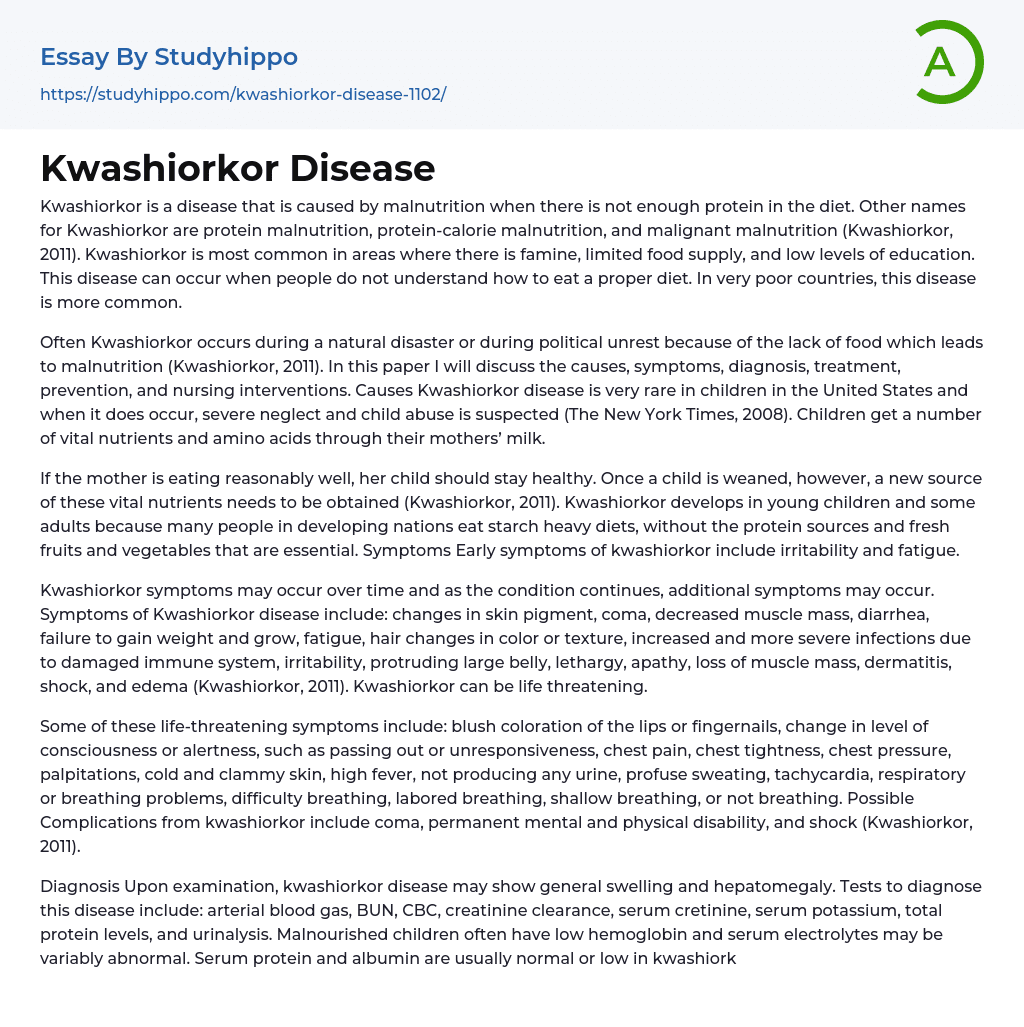Kwashiorkor is a disease that is caused by malnutrition when there is not enough protein in the diet. Other names for Kwashiorkor are protein malnutrition, protein-calorie malnutrition, and malignant malnutrition (Kwashiorkor, 2011). Kwashiorkor is most common in areas where there is famine, limited food supply, and low levels of education. This disease can occur when people do not understand how to eat a proper diet. In very poor countries, this disease is more common.
Often Kwashiorkor occurs during a natural disaster or during political unrest because of the lack of food which leads to malnutrition (Kwashiorkor, 2011). In this paper I will discuss the causes, symptoms, diagnosis, treatment, prevention, and nursing interventions. Causes Kwashiorkor disease is very rare in children in the United States and when it does occur, severe neglect and child abuse is suspected (The New York Times, 2008). Ch
...ildren get a number of vital nutrients and amino acids through their mothers’ milk.
If the mother is eating reasonably well, her child should stay healthy. Once a child is weaned, however, a new source of these vital nutrients needs to be obtained (Kwashiorkor, 2011). Kwashiorkor develops in young children and some adults because many people in developing nations eat starch heavy diets, without the protein sources and fresh fruits and vegetables that are essential. Symptoms Early symptoms of kwashiorkor include irritability and fatigue.
Kwashiorkor symptoms may occur over time and as the condition continues, additional symptoms may occur. Symptoms of Kwashiorkor disease include: changes in skin pigment, coma, decreased muscle mass, diarrhea, failure to gain weight and grow, fatigue, hair changes in color or texture, increased and more severe infections due to damaged immune system, irritability,
protruding large belly, lethargy, apathy, loss of muscle mass, dermatitis, shock, and edema (Kwashiorkor, 2011). Kwashiorkor can be life threatening.
Some of these life-threatening symptoms include: blush coloration of the lips or fingernails, change in level of consciousness or alertness, such as passing out or unresponsiveness, chest pain, chest tightness, chest pressure, palpitations, cold and clammy skin, high fever, not producing any urine, profuse sweating, tachycardia, respiratory or breathing problems, difficulty breathing, labored breathing, shallow breathing, or not breathing. Possible Complications from kwashiorkor include coma, permanent mental and physical disability, and shock (Kwashiorkor, 2011).
Diagnosis Upon examination, kwashiorkor disease may show general swelling and hepatomegaly. Tests to diagnose this disease include: arterial blood gas, BUN, CBC, creatinine clearance, serum cretinine, serum potassium, total protein levels, and urinalysis. Malnourished children often have low hemoglobin and serum electrolytes may be variably abnormal. Serum protein and albumin are usually normal or low in kwashiorkor (The New York Times, 2008). Treatment If treated is started early enough, getting more calories and protein will correct kwashiorkor.
Children who have this condition will never reach their full growth. Depending on the severity of the condition, people who are in shock need immediate treatment to restore blood volume and maintain blood pressure. Food must be reintroduced slowly since the person will have been without much food for a long period of time. Eating can cause problems, especially if the calories are too high at first. Calories are given first in the form of simple sugars, fats, and carbohydrates. Proteins are started after other sources of calories have already provided energy.
Vitamin and mineral supplements are essential. Carbohydrates are given first to supply energy, followed by protein
foods. Many malnourished children will develop lactose intolerance and may need to be given supplements with the enzyme lactase so they can tolerate milk products. Treatment done early usually leads to good results. Treating kwashiorkor in the late stages will improve the child’s health, but the child may be left will permanent physical and mental problems. This condition is life-threatening if treatment is not given or comes too late (Kwashiorkor, 2011).
Prevention Prevention can be done by making sure the diet has adequate carbohydrates, fat, and protein. Fat should be at least ten percent of total calories and protein should be twelve percent of total calories (Kwashiorkor, 2011). Providing a variety of different foods can help the child get all the nutrients needed for a healthy diet. If income is low and assistance is needed, it is important to get aid if possible to prevent this disease. Nursing Interventions Education is the number one priority nurses can do to prevent this from happening or to treat Kwashiorkor disease.
It is imperative that nurses be at the forefront in educating and reinforcing healthy nutrition habits in parents of small children to prevent malnutrition. Teaching parents and families about a healthy diet is essential. Making sure the family has adequate food and knows the importance of a balanced diet can help prevent this disease and also help treat it (The New York Times, 2008). Conclusion Kwashiorkor disease is not very common in the United States but is most common in areas where there is limited food supply and low levels of education.
- Pregnancy essays
- Death essays
- Asthma essays
- Chronic Pain essays
- Diabetes essays
- Infection essays
- Infertility essays
- Pain essays
- Sexually Transmitted Disease essays
- Cholesterol essays
- Epidemic essays
- Pathogen essays
- Symptom essays
- Water supply essays
- Myocardial Infarction essays
- Chronic essays
- Hypertension essays
- Black Death essays
- Breast Cancer essays
- Down Syndrome essays
- Apoptosis essays
- Tuskegee Syphilis Experiment essays
- Type 2 Diabetes essays
- Food Safety essays
- Food Security essays
- Beverages essays
- Cuisines essays
- Dairy essays
- Desserts essays
- Fast Food essays
- Bread essays
- Meal essays
- Meat essays
- Organic Food essays
- Rice essays
- Sugar essays
- Taste essays
- Beef essays
- Coconut essays
- Crowd essays
- Dinner essays
- Juice essays
- Sainsbury essays
- Cooking essays
- Ginger essays
- Oreo essays
- Drink essays
- Beer essays
- Wine essays
- Coffee essays




